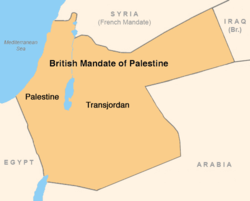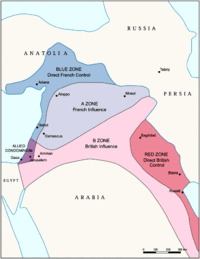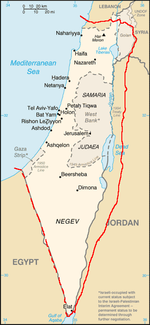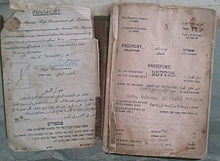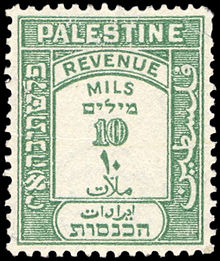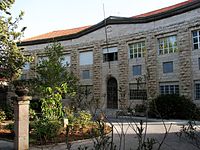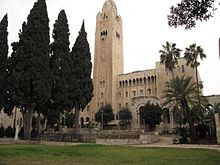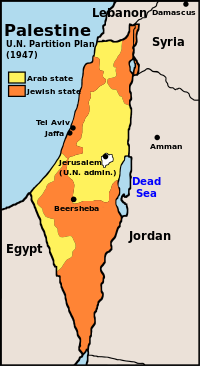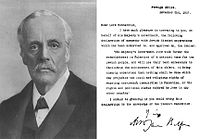- British Mandate for Palestine
-
Mandate for Palestine
الانتداب البريطاني على فلسطين
המנדט הבריטי על פלשתינה א"יMandate of the United Kingdom ← 
1920–1948  →
→
 →
→
 →
→
 →
→

Flag Public Seal The Mandate for Palestine borders as eventually determined Capital Jerusalem Language(s) English, Arabic, Hebrew Political structure League of Nations Mandate High Commissioners - 1920–1925 Sir Herbert Louis Samuel - 1945–1948 Sir Alan G. Cunningham Historical era Interwar Period - Mandate assigned 25 April 1920 - Britain officially assumes control 29 September 1923 - Transjordanian independence 25 May 1946 - Israel independence 14 May 1948 Currency Palestine pound Today part of  Israel
Israel
 Jordan
Jordan
 Palestinian territories
Palestinian territories
 Saudi Arabia
Saudi Arabia
 Iraq
Iraq- This article deals with the Mandate instrument passed by the League of Nations granting Britain a mandate over the area currently occupied by Israel, the West Bank, Gaza Strip and Jordan. For a history of the period, see Mandate Palestine.
The British Mandate for Palestine, also known as the Palestine Mandate, The British Mandate of Palestine and the Mandate for Palestine,[1] was a legal commission for the administration of Palestine, the draft of which was formally confirmed by the Council of the League of Nations on 24 July 1922 and which came into effect on 26 September 1923.[2] The document was based on the principles contained in Article 22 of the draft Covenant of the League of Nations and the San Remo Resolution of 25 April 1920 by the principal Allied and associated powers after the First World War.[2] The mandate formalised British rule in the southern part of Ottoman Syria from 1923–1948. With the League of Nations' consent on 16 September 1922, the UK divided the Mandate territory into two administrative areas, Palestine, under direct British rule, and autonomous Transjordan, under the rule of the Hashemite family from the Kingdom of Hejaz in present-day Saudi Arabia, in accordance with the McMahon Correspondence of 1915.[2] Following the 1922 Transjordan memorandum, the area east of the Jordan river became exempt from the Mandate provisions concerning the Jewish National Home.[2][3]
The preamble of the mandate declared:
Whereas the Principal Allied Powers have also agreed that the Mandatory should be responsible for putting into effect the declaration originally made on November 2nd, 1917, by the Government of His Britannic Majesty, and adopted by the said Powers, in favour of the establishment in Palestine of a national home for the Jewish people, it being clearly understood that nothing should be done which might prejudice the civil and religious rights of existing non-Jewish communities in Palestine, or the rights and political status enjoyed by Jews in any other country.[4]
The formal objective of the League of Nations Mandate system was to administer parts of the defunct Ottoman Empire, which had been in control of the Middle East since the 16th century, "until such time as they are able to stand alone."[5]
Contents
Background
Strategy against the Ottoman Empire
When the Ottoman Empire joined the Central Powers in the First World War in April 1915, it threatened Britain's communications with India via the Suez Canal, besides other strategic interests of the allies. The conquest of Palestine was thus part of an articulated strategy by Britain's military and political leadership aimed at establishing a land bridge between the Mediterranean and the Persian Gulf. This would enable rapid deployment of troops to the Gulf, then the forward line of defense for British interests in India, and protect against invasion from the north by Russia. A land bridge was also an alternative to the Suez Canal.[6]
In response to French initiatives, the United Kingdom established the De Bunsen Committee in 1915 to consider the nature of British objectives in Turkey and Asia in the event of a successful conclusion of the war. The committee considered various scenarios and provided guidelines for negotiations with France, Italy, and Russia regarding the partitioning of the Ottoman Empire. The Committee recommended in favour of the creation of a decentralised and federal Ottoman state in Asia.[7]
At the same time, the British and French also opened overseas fronts with the Gallipoli (1915) and Mesopotamian campaigns. In Gallipoli, the Turks successfully repelled the British, French and Australian and New Zealand Army Corps (ANZACs).
In 1916, Britain and France concluded the Sykes–Picot Agreement, which proposed to divide the Middle East between them into spheres of influence, with "Palestine" as an international enclave. (Pappé 1994, p. 3)
The British made two potentially conflicting promises regarding the territory it was expecting to acquire.[8] Britain had promised Hussein bin Ali, Sharif of Mecca, through T. E. Lawrence, independence for an Arab country covering most of the Arab Middle East in exchange for his support, while also promising to create and foster a Jewish national home in Palestine in the Balfour Declaration of 1917, in return for Jewish support.
World War I in the Middle East
 Field Marshall Allenby entering Jerusalem with British troops on 11 December 1917
Field Marshall Allenby entering Jerusalem with British troops on 11 December 1917
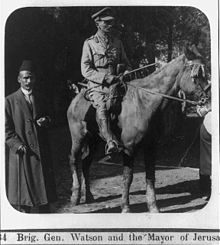 General Watson meeting with the Mayor of Jerusalem in December 1917
General Watson meeting with the Mayor of Jerusalem in December 1917
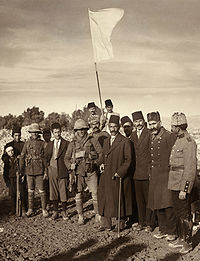 The surrender of Jerusalem by the Ottomans to the British on 9 December 1917 following the Battle of Jerusalem
The surrender of Jerusalem by the Ottomans to the British on 9 December 1917 following the Battle of Jerusalem
From 1915, Zionist leader and anglophile Ze'ev Jabotinsky was pressing the British to agree to the formation of a Zionist volunteer corps that would serve under the aegis of the British army. The British eventually agreed to set up the Zion Mule Corps, which assisted in the failed invasion of Gallipoli.
After Lloyd George was made prime minister during the war, the British waged the Sinai and Palestine Campaign under General Allenby. This time the British agreed to a "Jewish Legion", which participated in the invasion. Russian Jews regarded the German army as a liberator and the creation of the Legion was designed to encourage them to participate in the war on Britain's side.
At the same time, British intelligence officer T. E. Lawrence ("Lawrence of Arabia") was encouraging an Arab Revolt led by the Sharif of Mecca.
The British defeated Ottoman Turkish forces in 1917 and occupied Palestine and Syria. The land remained under British military administration for the remainder of the war, and beyond.
After the War
The Ottoman Empire capitulated on 30 October 1918, and on 23 November 1918, a military edict was issued dividing Ottoman territories into "occupied enemy territories" (OET). The Middle East was divided into three OETs. Occupied Enemy Territory South extended from the Egyptian border of Sinai into Palestine and Lebanon as far north as Acre and Nablus and as far east as the River Jordan. A temporary British military governor (Major General, Sir Arthur Wigram Money) would administer this sector.[9][10][11] At that time, General Allenby assured Amir Faisal "that the Allies were in honour bound to endeavour to reach a settlement in accordance with the wishes of the peoples concerned and urged him to place his trust whole-heartedly in their good faith."[12]
In a meeting at Deauville in 1919, David Lloyd George of the UK and Georges Clemenceau of France finalised the Anglo-French Settlement of 1–4 December 1918. The new agreement allocated Palestine and the Vilayet of Mosul to the British in exchange for British support of French influence in Syria and Lebanon.[13][14]
In October 1919, British forces in Syria and the last British soldiers stationed east of the Jordan were withdrawn and the region came under exclusive control of Faisal bin Hussein from Damascus. (Biger 2004, p. 173)
At the Paris Peace Conference, Prime Minister Lloyd George told Georges Clemenceau and the other allies that the McMahon-Hussein correspondence was a treaty obligation. He explained that the agreement with Hussein had actually been the basis for the Sykes-Picot Agreement, and that the French could not use the proposed League Of Nations Mandate system to break the terms of the agreement. He pointed out that the French had agreed not to occupy the area of the independent Arab state, or confederation of states, with their military forces, including the areas of Damascus, Homs, Hama, and Aleppo. Arthur Balfour (later Lord Balfour, British Foreign Secretary at the time) and President Woodrow Wilson were present at the meeting.[15]
The open negotiations began at the Paris Peace Conference, continued at the Conference of London and took definite shape only after the San Remo conference in April 1920. There the Allied Supreme Council granted the mandates for Palestine and Mesopotamia to Britain,[16] and those for Syria and Lebanon to France. In August 1920, this was officially acknowledged in the Treaty of Sèvres. Both Zionist and Arab representatives attended the conference, where they signed the Faisal–Weizmann Agreement[17]. The agreement was never implemented.
The Mandate
Practical and legal basis
 Emir Faisal's delegation at Versailles, during the Paris Peace Conference of 1919. Left to right: Rustum Haidar, Nuri as-Said, Prince Faisal, Captain Pisani (behind Faisal), T. E. Lawrence, Captain Hassan Khadri
Emir Faisal's delegation at Versailles, during the Paris Peace Conference of 1919. Left to right: Rustum Haidar, Nuri as-Said, Prince Faisal, Captain Pisani (behind Faisal), T. E. Lawrence, Captain Hassan Khadri
The Official Journal of the League of Nations, dated June 1922, contained an interview with Lord Balfour in which he opined that the League's authority was strictly limited. According to Balfour –
[the] Mandates were not the creation of the League, and they could not in substance be altered by the League. The League's duties were confined to seeing that the specific and detailed terms of the mandates were in accordance with the decisions taken by the Allied and Associated Powers, and that in carrying out these mandates the Mandatory Powers should be under the supervision—not under the control—of the League. A mandate was a self-imposed limitation by the conquerors on the sovereignty which they exercised over the conquered territory.[18]
Each of the principal Allied powers had a hand in drafting the proposed mandate[19]—although some, including the United States, had not declared war on the Ottoman Empire and did not become members of the League of Nations.
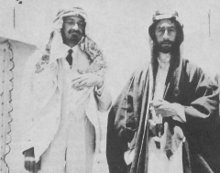 Emir Feisal I (right) and Chaim Weizmann (also wearing Arab garment as a sign of friendship) in Syria, 1918
Emir Feisal I (right) and Chaim Weizmann (also wearing Arab garment as a sign of friendship) in Syria, 1918
The Sykes-Picot Agreement did not call for Arab sovereignty, but for the "suzerainty of an Arab chief" and "an international administration, the form of which is to be decided upon after consultation with Russia, and subsequently in consultation with the other allies, and the representatives of the Sherif of Mecca."[20] Under the terms of that agreement, the Zionist Organization needed to secure an agreement along the lines of the Faisal-Weizmann Agreement with the Sherif of Mecca.
At the Peace Conference in 1919, Emir Faisal, speaking on behalf of King Hussein, asked for Arab independence, or at minimum the right to pick the mandatory.[21] In the end, he recommended an Arab state under a British mandate.[22] The World Zionist Organization also asked for a British mandate, and asserted the 'historic title of the Jewish people to Palestine'.[23]
A confidential appendix to the report of the King-Crane Commission observed that "The Jews are distinctly for Britain as mandatory power, because of the Balfour declaration' and that the French 'resent the payment by the English to the Emir Feisal of a large monthly subsidy, which they claim covers a multitude of bribes, and enables the British to stand off and show clean hands while Arab agents do dirty work in their interest."[24] The Faisal-Weizmann Agreement called for British mediation of any disputes. It also called for the establishment of borders, after the Versailles peace conference, by a commission to be formed for the purpose. The World Zionist Organization later submitted to the peace conference a proposed map of the territory that did not include the area east of the Hedjaz Railway, including most of Transjordan. In the Sanremo Conference (24 April 1920) the Mandate for Palestine was allocated to Great Britain. France required the continuation of its religious protectorate in Palestine but Italy and Great Britain opposed it. France lost the religious protectorate but thanks to the Holy See continued to enjoy liturgical honours in Mandatory Palestine until 1924 when the honours were abolished (see: Protectorate of the Holy See).[25]
The mandate was a legal and administrative instrument, not a geographical territory.[26] The territorial jurisdiction of the mandate was subject to change by treaty, capitulation, grant, usage, sufferance or other lawful means. To many observers it seemed as though the boundary of Britain's mandate for Palestine was to extend eastward to the western boundary of its mandate for Mesopotamia.[27] However, the area east of a line from Damascus, Homs, Hamma, and Aleppo – including most of Transjordan – had been pledged in 1915 as part of an undertaking between the UK and the Sharif Hussein of Mecca. The area east of the Jordan River 'was included in the areas as to which Great Britain [sic] pledged itself that they should be Arab and independent in the future'. At the 1919 Peace Conference, the Zionist Organization's claims did not include any territory east of the Hedjaz Railway. The Faisal-Weizmann Agreement provided that the boundaries between the Arab state and Palestine should be determined by a commission after the Paris Peace Conference.
The proposed Arab state and Jewish national home called for separate boundaries and administrative regimes in the sub-districts of historical Cisjordan (west of the Jordan River) and Transjordan (east of the Jordan River). The Palestine Order in Council provided that:
The High Commissioner may, with the approval of a Secretary of State, by Proclamation divide Palestine into administrative divisions or districts in such manner and with such subdivisions as may be convenient for purposes of administration describing the boundaries thereof and assigning names thereto.[28]
Transjordan (Article 25)
Under the terms of the McMahon-Hussein correspondence and Sykes-Picot agreements, the land east of the Jordan was to be part of an Arab state or confederation of Arab states part of the purpose of which was to create an Arab territory east of the Jordan River. When the Inter-Allied Conference at San Remo adjourned in April 1920, the text of the Palestine mandate did not contain Article 25, or mention "the territories lying between the Jordan and the eastern boundary of Palestine as ultimately determined". Sanford Silverburg said that "a Palestine" within the western political understanding of the term simply never existed." He observed that the failure to establish a western-based territorial element or frame of reference had clouded discussions and cited the claim that Transjordan had been detached from Palestine as a non-sequitur.[29]
Mary Wilson said that the territory east of the Jordan between Damascus and Ma'an had been ruled as part of Faisal's Kingdom of Syria since the end of the war. Wilson said that was because it fell within the indirect sphere of British influence according to the Sykes-Picot agreement, and because the British were content with that arrangement. They favoured Arab rule in the interior, because they didn't have enough troops to garrison the territory. Damascus was located in the French indirect sphere of influence, and the Sykes-Picot agreement called for Arab rule there too. Wilson notes that when France occupied Damascus in July 1920, the situation had changed dramatically. The British suddenly wanted to know 'what is the "Syria" for which the French received a mandate at San Remo?' and 'does it include Transjordania?.[30] British Foreign Minister Curzon ultimately decided that it did not and that Transjordan would remain independent, but in the closest relation with Palestine.
Aaron Klieman said that the French formed a new Damascus state after the Battle of Maysalun. As a result, Curzon instructed Vansittart (Paris) to leave the eastern boundary of Palestine undefined. On 21 March 1921, the Foreign and Colonial office legal advisers decided to introduce Article 25 into the Palestine Mandate. It was approved by Curzon on 31 March 1921, and the revised final draft of the mandate (including Transjordan) was forwarded to the League of Nations on 22 July 1922.[31]
Article 25 of the mandate recognised the McMahon-Hussein correspondence. It permitted the mandatory to "postpone or withhold application of such provisions of the mandate as he may consider inapplicable to the existing local conditions" in that region. The future Transjordan had been part of the Syrian administrative unit under the Ottomans. It was part of the captured territory placed under the Allied Occupied Enemy Territory Administration (OETA).[32][33]
At the Battle of Maysalun on 23 July 1920, the French removed the newly-proclaimed nationalist government of Hashim al-Atassi and expelled King Faisal from Syria. British Foreign Secretary Earl Curzon wrote to the High Commissioner, Herbert Samuel, in August 1920, stating, "I suggest that you should let it be known forthwith that in the area south of the Sykes-Picot line, we will not admit French authority and that our policy for this area to be independent but in closest relations with Palestine."[34] Samuel replied to Curzon, "After the fall of Damascus a fortnight ago...Sheiks and tribes east of Jordan utterly dissatisfied with Shareefian Government most unlikely would accept revival"[35] and subsequently announced that Transjordan was under British Mandate.[36] Without authority from London, Samuel then visited Transjordan and at a meeting with 600 leaders in Salt, announced the independence of the area from Damascus and its absorption into the mandate, quadrupling the area under his control by tacit capitulation. Samuel assured his audience that Transjordan would not be merged with Palestine.[36] The foreign secretary, Lord Curzon, repudiated Samuel's action.[37]
The Cairo Conference was convened by Winston Churchill, then Britain's Colonial Secretary, to resolve the problem. With the mandates of Palestine and Iraq awarded to Britain, Churchill wished to consult with Middle East experts. At his request, Gertrude Bell, Sir Percy Cox, T. E. Lawrence, Sir Kinahan Cornwallis, Sir Arnold T. Wilson, Iraqi minister of war Jaʿfar alAskari, Iraqi minister of finance Sasun Effendi (Sasson Heskayl), and others gathered in Cairo, Egypt, in March 1921. The outstanding question was the policy to be adopted in Transjordan to prevent anti-French military actions from being launched within the allied British zone of influence. The Hashemites were Associated Powers during the war, and a peaceful solution was urgently needed.
The two most significant decisions of the conference were to offer the throne of Iraq to Emir Faisal ibn Hussein (who became Faisal I of Iraq) and an emirate of Transjordan (now Jordan) to his brother Abdullah ibn Hussein (who became Abdullah I of Jordan). Transjordan was to be constituted as an Arab province of Palestine. The conference provided the political blueprint for British administration in both Iraq and Transjordan, and in offering these two regions to the sons of Sharif Hussein ibn Ali of the Hedjaz, Churchill believed that the spirit, if not the letter, of Britain's wartime promises to the Arabs might be fulfilled.
After further discussions between Churchill and Abdullah in Jerusalem, it was mutually agreed that Transjordan was accepted into the mandatory area with the proviso that it would be, initially for six months, under the nominal rule of the Emir Abdullah and would not form part of the Jewish national home to be established west of the River Jordan.[38][39]
That agreement was formalised before the mandate officially went into effect. An article was included in the Mandate for Palestine which allowed the UK to postpone or withhold unspecified provisions from the lands which lay to the east of the Jordan River.[40] On 16 September 1922, the League of Nations approved a British memorandum detailing its intended implementation of that clause, namely to exclude Transjordan from the articles related to Jewish settlement.[41][42]
From that point onwards, Britain administered the 23% west of the Jordan as "Palestine", and the 77% east of the Jordan as "Transjordan." The subsequent two mandates were administrated under one single British Foreign Office High Commissioner which does not prejudice or vacate the international principle whereof official League of Nations documents referred to them as if they were two separate mandates. Transfer of authority to an Arab government took place gradually in Transjordan, starting with the recognition of a local administration in 1923 and transfer of most administrative functions in 1928. The status of the mandate was not altered by the agreement between the United Kingdom and the Emirate concluded on 20 February 1928.[43][44] It recognised the existence of an independent government in Transjordan and defined and limited its powers. The ratifications were exchanged on 31 October 1929."[45] Britain retained mandatory authority over the region until it became independent as the Hashemite Kingdom of Transjordan in 1946. The juridical status of the mandate under the Palestine Mandate Convention remained unchanged pending a decision on the Palestine question by the United Nations or Transjordan's admission to the United Nations as an independent state. See Termination of the Mandate.
Religious and communal issues
Article 14 of the Mandate required Britain to establish a commission to study, define, and determine the rights and claims relating to the different religious communities in Palestine. This provision, which called for the creation of a commission to review the religious status quo between the religious communities, was never created.
Article 15 required the mandatory administration to see to it that complete freedom of conscience and the free exercise of all forms of worship were permitted.
Demarcation of borders
Main article: Borders of IsraelDuring and after World War I, Britain made conflicting and shifting commitments regarding the future division and governance of the region, including those announced in the Balfour Declaration of 1917, the Sykes-Picot Agreement, the McMahon–Hussein Correspondence, and the Churchill White Paper of 1922. At the San Remo conference, the boundaries of the mandated territories were not precisely defined.[16][46]
The boundary between the British and French mandates was defined in broad terms by the Franco-British Boundary Agreement of December 1920.[47] That agreement placed the bulk of the Golan Heights in the French sphere. The treaty also established a joint commission to settle the precise border and mark it on the ground.[47] The commission submitted its final report on 3 February 1922, and it was approved with some caveats by the British and French governments on 7 March 1923, several months before Britain and France assumed their Mandatory responsibilities on 29 September 1923.[48][49] Under the treaty, Syrian and Lebanese residents would have the same fishing and navigation rights on Lake Hula, Lake Tiberias, and the Jordan River as citizens of the Palestine Mandate, but the government of Palestine would be responsible for policing of the lakes. The Zionist movement pressured the French and British to include as much water sources as possible to Palestine during the demarcating negotiations. These constant demands influenced the negotiators and finally led to the inclusion of the whole Sea of Galilee, both sides of the Jordan river, Lake Hula, Dan spring, and part of the Yarmouk. The High Commissioner of Palestine, Herbert Samuel, had demanded full control of the Sea of Galilee.[50] The new border followed a 10-meter wide strip along the northeastern shore.[51]
Following the settlement of the border issue, the British and French governments signed on 2 February 1926 an Agreement of good neighbourly Relations between the mandated territories of Palestine, Syria and Lebanon.[52]
Drafting of the mandate
The British Foreign Secretary, Lord Curzon, together with the Italian and French governments rejected early drafts of the mandate because it had contained a passage which read: "Recognizing, moreover, the historical connection of the Jewish people with Palestine and the claim which this gives them to reconstitute it their national home..."
The Palestine Committee set up by the Foreign Office recommended that the reference to 'the claim' be omitted. The Allies had already noted the historical connection in the Treaty of Sèvres, but they had recognised no legal claim. They felt that whatever might be done for the Jewish people was based entirely on sentimental grounds. Further, they felt that all that was necessary was to make room for Zionists in Palestine, not that they should turn 'it', that is the whole country, into their home.[citation needed]
Lord Balfour suggested an alternative which was accepted.
Whereas recognition has thereby [i.e. by the Treaty of Sèvres] been given to the historical connection of the Jewish people with Palestine, and to the [sentimental] grounds for reconstituting their National Home in that country ...[53]
The Vatican, the Italian, and the French governments continued to press their own legal claims on the basis of the former Protectorate of the Holy See and the French Protectorate of Jerusalem. The idea of an International Commission to resolve claims on the Holy Places had been formalised in Article 95 of the Treaty of Sèvres, and taken up again in article 14 of the Palestinian Mandate. Negotiations concerning the formation and the role of the commission were partly responsible for the delay in ratifying the mandate. The UK assumed responsibility for the Holy Places under Article 13 of the mandate. However, it never created the Commission on Holy Places to resolve the other claims in accordance with Article 14 of the mandate.[54]
The High Commissioner established the authority of the Orthodox Rabbinate over the members of the Jewish community and retained a modified version of the old Ottoman Millet system. Formal recognition was extended to eleven religious communities, which did not include the non-Orthodox Jewish or Protestant Christian denominations.
League of Nations ratification
The San Remo conference[55] assigned the mandate for Palestine to the United Kingdom under Article 22 of the Covenant of the League of Nations. The Allies also decided to make the UK responsible for putting into effect its own Balfour Declaration of 1917. In June 1922, the League of Nations approved the terms of the mandate, with the stipulation that they would not come into effect until a dispute between France and Italy over the Syria Mandate was settled. That issue was resolved in September 1923. The Council of the League of Nations determined that the two mandates had come into effect at its meeting of 29 September 1923.[56]
United States legal rights in Palestine
The United States was not a member of the League of Nations, and consequently was not required to officially state its position on the legality of the Palestinian Mandate. However, the US government accepted the de facto, if not de jure, status of the mandates and entered into individual treaties with the mandatory power to secure legal rights for its citizens and to protect property rights and business interests in the mandates. In the case of Palestine, on 3 December 1924, it entered into a bilateral treaty with Britain in the Palestine Mandate Convention, in which the United States "consents to the administration" (Article 1) and which dealt with eight issues of concern to the United States.[57][58]
Jewish national home
In 1919 the General Secretary (and future President) of the Zionist Organization, Nahum Sokolow, published History of Zionism (1600–1918). He also represented the Zionist Organization at the Paris Peace Conference.
“ The object of Zionism is to establish for the Jewish people a home in Palestine secured by public law." ... ...It has been said and is still being obstinately repeated by anti-Zionists again and again, that Zionism aims at the creation of an independent "Jewish State" But this is fallacious. The "Jewish State" was never part of the Zionist programme. The Jewish State was the title of Herzl's first pamphlet, which had the supreme merit of forcing people to think. This pamphlet was followed by the first Zionist Congress, which accepted the Basle programme – the only programme in existence. ” —Nahum Sokolow, History of Zionism[59]
The United Nations Special Committee on Palestine said the Jewish National Home, which derived from the formulation of Zionist aspirations in the 1897 Basle program has provoked many discussions concerning its meaning, scope and legal character, especially since it had no known legal connotation and there are no precedents in international law for its interpretation. It was used in the Balfour Declaration and in the Mandate, both of which promised the establishment of a "Jewish National Home" without, however, defining its meaning. A statement on "British Policy in Palestine," issued on 3 June 1922 by the Colonial Office, placed a restrictive construction upon the Balfour Declaration. The statement included "the disappearance or subordination of the Arabic population, language or customs in Palestine" or "the imposition of Jewish nationality upon the inhabitants of Palestine as a whole", and made it clear that in the eyes of the mandatory Power, the Jewish National Home was to be founded in Palestine and not that Palestine as a whole was to be converted into a Jewish National Home. The Committee noted that the construction, which restricted considerably the scope of the National Home, was made prior to the confirmation of the Mandate by the Council of the League of Nations and was formally accepted at the time by the Executive of the Zionist Organization.[60]
The League of Nations Permanent Mandates Commission took the position that the Mandate contained a dual obligation. In 1932 the Mandates Commission questioned the representative of the Mandatory on the demands made by the Arab population regarding the establishment of self-governing institutions, in accordance with various articles of the mandate, and in particular Article 2. The Chairman noted that "under the terms of the same article, the mandatory Power had long since set up the Jewish National Home."[61]
In March 1930 Lord Passfield, the Secretary of State for the Colonies, had written a Cabinet Paper[62] which said:
In the Balfour Declaration there is no suggestion that the Jews should be accorded a special or favoured position in Palestine as compared with the Arab inhabitants of the country, or that the claims of Palestinians to enjoy self-government (subject to the rendering of administrative advice and assistance by a Mandatory as foreshadowed in Article XXII of the Covenant) should be curtailed in order to facilitate the establishment in Palestine of a National Home for the Jewish people." ... Zionist leaders have not concealed and do not conceal their opposition to the grant of any measure of self-government to the people of Palestine either now or for many years to come. Some of them even go so far as to claim that that provision of Article 2 of the Mandate constitutes a bar to compliance with the demand of the Arabs for any measure of self-government. In view of the provisions of Article XXII of the Covenant and of the promises made to the Arabs on several occasions that claim is inadmissible.
In 1937 a British Royal Commission headed by Lord Peel proposed solving the Arab–Jewish conflict by partitioning Palestine into two states. The Jewish leadership rejected the plan and developed an alternate proposal.[63] The US Consul General at Jerusalem told the State Department that the Mufti had refused the principle of partition and declined to consider it. The Consul said that the Emir Abdullah urged acceptance on the ground that realities must be faced, but wanted modification of the proposed boundaries and Arab administrations in the neutral enclave. The Consul also noted that Nashashibi side-stepped the principle, but was willing to negotiate for favourable modifications.[64]
A collection of private correspondence published by David Ben Gurion contained a letter written in 1937 which explained that he was in favour of partition because he didn't envision a partial Jewish state as the end of the process. Ben Gurion wrote "What we want is not that the country be united and whole, but that the united and whole country be Jewish." He explained that a first-class Jewish army would permit Zionists to settle in the rest of the country with or without the consent of the Arabs.[65] Benny Morris said that both Chaim Weizmann and David Ben Gurion saw partition as a stepping stone to further expansion and the eventual takeover of the whole of Palestine.[66] Former Israeli Foreign Minister and historian Schlomo Ben Ami writes that 1937 was the same year that the "Field Battalions" under Yitzhak Sadeh wrote the "Avner Plan", which anticipated and laid the groundwork for what would become in 1948, Plan D. It envisioned going far beyond any boundaries contained in the existing partition proposals and planned the conquest of the Galilee, the West Bank, and Jerusalem.[67]
In 1942 the Biltmore Program was adopted as the platform of the World Zionist Organization. It demanded "that Palestine be established as a Jewish Commonwealth." In 1946 an Anglo-American Committee of Inquiry, also known as the Grady-Morrison Committee, noted that the demand for a Jewish State went beyond the obligations of either the Balfour Declaration or the Mandate and had been expressly disowned by the Chairman of the Jewish Agency as recently as 1932.[68] The Jewish Agency subsequently refused to accept the Grady Morrison Plan as the basis for discussion. A spokesman for the agency, Eliahu Epstein, told the US State Department that the Agency could not attend the London conference if the Grady-Morrison proposal was on the agenda. He stated that the Agency was unwilling to be placed in a position where it might have to compromise between the Grady-Morrison proposals on the one hand and its own partition plan on the other. He stated that the Agency had accepted partition as the solution for Palestine which it favoured.[69]
Palestine under the Mandate
Main article: Mandate PalestineFrom military to civil administration
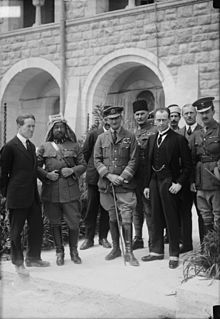 The arrival of Sir Herbert Samuel. From left to right: Col. T. E. Lawrence, Emir Abdullah, Air Marshal Sir Geoffrey Salmond, and Sir Wyndham Deedes and others
The arrival of Sir Herbert Samuel. From left to right: Col. T. E. Lawrence, Emir Abdullah, Air Marshal Sir Geoffrey Salmond, and Sir Wyndham Deedes and others
Following its occupation by British troops in 1917–1918, Palestine was governed by the Occupied Enemy Territory Administration. In July 1920, the military administration was replaced by a civilian administration headed by a High Commissioner.[70] The first High Commissioner, Herbert Samuel, arrived in Palestine on 20 June 1920, to take up his appointment from 1 July. Samuel continued in office when the mandate commenced in 1923.
In October 1923, Britain provided the League with a report on the administration of Palestine for the period 1920–1922, which covered the period before the mandate.[71]
Arab political rights
The resolution of the San Remo Conference contained a safeguarding clause for the existing rights of the non-Jewish communities. The conference accepted the terms of the Mandate with reference to Palestine, on the understanding that there was inserted in the process-verbal a legal undertaking by the Mandatory Power that it would not involve the surrender of the rights hitherto enjoyed by the non-Jewish communities in Palestine.[72] The draft mandates for Mesopotamia and Palestine, and all of the post-war peace treaties contained clauses for the protection of religious groups and minorities. The mandates invoked the compulsory jurisdiction of the Permanent Court of International Justice in the event of any disputes.[73]
Article 62 (LXII) of the Treaty of Berlin, 13 July 1878[74] dealt with religious freedom and civil and political rights in all parts of the Ottoman Empire.[75] The guarantees have frequently been referred to as "religious rights" or "minority rights". However, the guarantees included a prohibition against discrimination in civil and political matters. Difference of religion could not be alleged against any person as a ground for exclusion or incapacity in matters relating to the enjoyment of civil or political rights, admission to public employments, functions, and honours, or the exercise of the various professions and industries, "in any locality whatsoever."
A legal analysis performed by the International Court of Justice noted that the Covenant of the League of Nations had provisionally recognised the communities of Palestine as independent nations. The mandate simply marked a transitory period, with the aim and object of leading the mandated territory to become an independent self-governing State.[76] Judge Higgins explained that the Palestinian people are entitled to their territory, to exercise self-determination, and to have their own State."[77] The Court said that specific guarantees regarding freedom of movement and access to the Holy Sites contained in the Treaty of Berlin (1878) had been preserved under the terms of the Palestine Mandate and a chapter of the United Nations Partition Plan for Palestine.[78]
According to historian Rashid Khalidi, the mandate ignored the political rights of the Arabs.[79] The Arab leadership repeatedly pressed the British to grant them national and political rights, such as representative government, over Jewish national and political rights in the remaining 23% of the Mandate of Palestine which the British had set aside for a Jewish homeland. The Arabs reminded the British of President Wilson's Fourteen Points and British promises during the First World War. The British however made acceptance of the terms of the mandate a precondition for any change in the constitutional position of the Arabs. A legislative council was proposed in The Palestine Order in Council, of 1922 which implemented the terms of the mandate. It stated that: "No Ordinance shall be passed which shall be in any way repugnant to or inconsistent with the provisions of the Mandate." For the Arabs, this was unacceptable, as they felt that this would be "self murder".[80] During the whole interwar period, the British, appealing to the terms of the mandate, which they had designed themselves, rejected the principle of majority rule or any other measure that would give an Arab majority control over the government of Palestine.[81]
The terms of the mandate required the establishment of self-governing institutions in both Palestine and Transjordan. In 1947 Foreign Secretary Bevin admitted that during the previous twenty-five years the British had done, their best to further the legitimate aspirations of the Jewish communities without prejudicing the interests of the Arabs, but had failed to "secure the development of self-governing institutions" in accordance with the terms of the Mandate.[82]
The Jewish Yishuv
Main article: History of ZionismSee also: History of the State of IsraelDuring the Mandate, the Yishuv or Jewish community in Palestine, grew from one-sixth to almost one-third of the population. According to official records, 367,845 Jews and 33,304 non-Jews immigrated legally between 1920 and 1945.[83] It was estimated that another 50–60,000 Jews and a small number of non-Jews immigrated illegally during this period.[84] Immigration accounted for most of the increase of Jewish population, while the non-Jewish population increase was largely natural.[85]
Initially, Jewish immigration to Palestine met little opposition from the Palestinian Arabs. However, as anti-Semitism grew in Europe during the late 19th and early 20th centuries, Jewish immigration (mostly from Europe) to Palestine began to increase markedly, creating much Arab resentment. The British government placed limitations on Jewish immigration to Palestine. These quotas were controversial, particularly in the latter years of British rule, and both Arabs and Jews disliked the policy, each for its own reasons. In response to numerous Arab attacks on Jewish communities, the Haganah, a Jewish paramilitary organisation, was formed on 15 June 1920 to defend Jewish residents. Tensions led to widespread violent disturbances on several occasions, notably in 1921 (see Jaffa riots), 1929 (primarily violent attacks by Arabs on Jews—see 1929 Hebron massacre) and 1936–1939. Beginning in 1936, Jewish groups such as Etzel (Irgun) and Lehi (Stern Gang) conducted campaigns of violence against British military and Arab targets.
Infrastructure and development
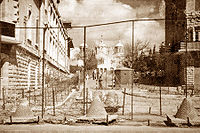 "Bevingrad" in Jerusalem, Russian Compound behind barbed wire
"Bevingrad" in Jerusalem, Russian Compound behind barbed wire
Between 1922 and 1947, the annual growth rate of the Jewish sector of the economy was 13.2%, mainly due to immigration and foreign capital, while that of the Arab was 6.5%. Per capita, these figures were 4.8% and 3.6% respectively. By 1936, the Jewish sector had eclipsed the Arab one, and Jewish individuals earned 2.6 times as much as Arabs.[86] Compared to other Arab countries, the Palestinian Arab individuals earned slightly more.[87] In terms of human capital, there was a huge difference. For instance, the literacy rates in 1932 were 86% for the Jews against 22% for the Palestinian Arabs, but Arab literacy was steadily increasing. In this respect, the Palestinian Arabs compared favourably to Egypt and Turkey, but unfavourably to Lebanon.[88] On the scale of the UN Human Development Index determined for around 1939, of 36 countries, Palestinian Jews were placed 15th, Palestinian Arabs 30th, Egypt 33rd and Turkey 35th.[89] The Jews in Palestine were mainly urban, 76.2% in 1942, while the Arabs were mainly rural, 68.3% in 1942.[90] Overall, Khalidi concludes that Palestinian Arab society, while overmatched by the Yishuv, was as advanced as any other Arab society in the region and considerably more than several.[91]
Under the British Mandate, the country developed economically and culturally. In 1919 the Jewish community founded a centralised Hebrew school system, and the following year established the Assembly of Representatives, the Jewish National Council and the Histadrut labour federation. The Technion university was founded in 1924, and the Hebrew University of Jerusalem in 1925.[92]
Palestinian Arab leadership
Under the British Mandate, the office of “Mufti of Jerusalem”, traditionally limited in authority and geographical scope, was refashioned into that of “Grand Mufti of Palestine”. Furthermore, a Supreme Muslim Council (SMC) was established and given various duties, such as the administration of religious endowments and the appointment of religious judges and local muftis. In Ottoman times, these duties had been fulfilled by the bureaucracy in Istanbul.[93] In dealings with the Palestinian Arabs, the British negotiated with the elite rather than the middle or lower classes.(Khalidi 2006, p. 52) They chose Hajj Amin al-Husayni to become Grand Mufti, although he was young and had received the fewest votes from Jerusalem’s Islamic leaders.(Khalidi 2006, pp. 56–57) One of the mufti's rivals, Raghib Bey al-Nashashibi, had already been appointed mayor of Jerusalem in 1920, replacing Musa Kazim, whom the British removed after the Nabi Musa riots of 1920,[94][95] during which he exhorted the crowd to give their blood for Palestine.[96] During the entire Mandate period, but especially during the latter half, the rivalry between the mufti and al-Nashashibi dominated Palestinian politics. Khalidi ascribes the failure of the Palestinian leaders to enroll mass support, because of their experiences during the Ottoman Empire period, as they were then part of the ruling elite and accustomed to their commands being obeyed. The idea of mobilising the masses was thoroughly alien to them.(Khalidi 2006, p. 81)
There had already been rioting and attacks on and massacres of Jews in 1921 and 1929. During the 1930s, Palestinian Arab popular discontent with Jewish immigration grew. In the late 1920s and early 1930s, several factions of Palestinian society, especially from the younger generation, became impatient with the internecine divisions and ineffectiveness of the Palestinian elite and engaged in grass-roots anti-British and anti-Zionist activism, organised by groups such as the Young Men's Muslim Association. There was also support for the radical nationalist Independence Party (Hizb al-Istiqlal), which called for a boycott of the British in the manner of the Indian Congress Party. Some took to the hills to fight the British and the Zionists. Most of these initiatives were contained and defeated by notables in the pay of the Mandatory Administration, particularly the mufti and his cousin Jamal al-Husayni. A six-month general strike in 1936 marked the start of the great Palestinian Revolt.[97]
United Nations partition plan
Main articles: 1947 UN Partition Plan and 1947-1948 Civil War in Mandatory PalestineThe British Peel Commission had proposed a Palestine divided between a Jewish state and an Arab state. But in the 1939 White Paper Britain changed its position and sought to limit Jewish immigration from Europe. This was seen by Zionists and their sympathisers as betrayal of the terms of the mandate, especially in light of the increasing persecution of Jews in Europe. In response, Zionists organised Aliyah Bet, a program of illegal immigration into Palestine. Lehi, a small group of extreme Zionists, staged armed attacks on British authorities in Palestine. However, the Jewish Agency, which represented the mainstream Zionist leadership, still hoped to persuade Britain to allow resumed Jewish immigration, and cooperated with Britain in World War II.
The Anglo-American Committee of Inquiry in 1946 was a joint attempt by Britain and the United States to agree on a policy regarding the admission of Jews to Palestine. In April, the Committee reported that its members had arrived at a unanimous decision. The Committee approved the American recommendation of the immediate acceptance of 100,000 Jewish refugees from Europe into Palestine. It also recommended that there be no Arab, and no Jewish State. The Committee stated that "in order to dispose, once and for all, of the exclusive claims of Jews and Arabs to Palestine, we regard it as essential that a clear statement of principle should be made that Jew shall not dominate Arab and Arab shall not dominate Jew in Palestine." U.S. President Harry S. Truman angered the British Labour Party by issuing a statement supporting the 100,000 refugees but refusing to acknowledge the rest of the committee's findings. Britain had asked for U.S assistance in implementing the recommendations. The U.S. War Department had said earlier that to assist Britain in maintaining order against an Arab revolt, an open-ended U.S. commitment of 300,000 troops would be necessary. The immediate admission of 100,000 new Jewish immigrants would almost certainly have provoked an Arab uprising.[98]
These events were the decisive factors that forced Britain to announce their desire to terminate the Palestine Mandate and place the Question of Palestine before the United Nations, the successor to the League of Nations. The UN created UNSCOP (the UN Special Committee on Palestine) on 15 May 1947, with representatives from 11 countries. UNSCOP conducted hearings and made a general survey of the situation in Palestine, and issued its report on 31 August. Seven members (Canada, Czechoslovakia, Guatemala, Netherlands, Peru, Sweden, and Uruguay) recommended the creation of independent Arab and Jewish states, with Jerusalem to be placed under international administration. Three members (India, Iran, and Yugoslavia) supported the creation of a single federal state containing both Jewish and Arab constituent states. Australia abstained. On 29 November, the UN General Assembly voted 33 to 13, with 10 abstentions, in favour of the Partition Plan, while making some adjustments to the boundaries between the two states proposed by it. The division was to take effect on the date of British withdrawal. It is important to note that the UN General Assembly is only granted the power to make recommendations, therefore, UNGAR 181 was not legally binding.[99] Both the U.S. and the Soviet Union supported the resolution. Haiti, Liberia, and the Philippines changed their votes at the last moment after concerted pressure from the U.S. and from Zionist organisations.[100][101][102] The five members of the Arab League who were voting members at the time voted against the Plan.
The Jewish Agency, which was the Jewish state-in-formation, accepted the plan, and nearly all the Jews in Palestine rejoiced at the news. Israeli history books mention 29 November as the most important date in the creation of Israel as it refers to UNGA 181 of 1947 Partition of the Mandate of Palestine into two states and whereof Israel's Proclamation of Independence refers to UNGA 181 as its source of sovereignty in Ph's 9 & 15.[citation needed]
The partition plan was rejected out of hand by Palestinian Arab leaders and by most of the Arab population. Meeting in Cairo in November and December 1947, the Arab League then adopted a series of resolutions aimed at a military solution to the conflict.
Britain announced that it would accept the partition plan, but refused to enforce it, arguing it was not acceptable to both sides. Britain also refused to share the administration of Palestine with the UN Palestine Commission during the transitional period. In September 1947, the British government announced that the Mandate for Palestine would end at midnight on 14 May 1948.[103][104][105]
Some Jewish organizations also opposed the proposal. Irgun leader Menachem Begin announced: "The partition of the homeland is illegal. It will never be recognised. The signature by institutions and individuals of the partition agreement is invalid. It will not bind the Jewish people. Jerusalem was and will for ever be our capital. The Land of Israel will be restored to the people of Israel. All of it. And for ever."[citation needed] These views were publicly rejected by the majority of the nascent Jewish state.[citation needed]
Termination of the Mandate
The Yalta Conference mentioned that mandates should be placed under United Nations trusteeship. The Jewish Agency knew the United Nations Charter would say something on those subjects. The Agency wrote a memo to the San Francisco Conference requesting a safeguarding clause that said no trusteeship agreement could alter the Jewish right to nationhood secured by the Balfour Declaration and the Palestine Mandate. The conference implicitly rejected that suggestion by stipulating in article 80 of the Charter that a trusteeship agreement could in fact alter a mandate.[106] The negotiating history of Article 80 of the UN Charter recorded in the Foreign Relations of the United States, indicates that it was developed as a "status quo" agreement with respect to the Palestine mandate. It was included at the insistence of the Arab League, who were afraid the 1939 White Paper policy would be relaxed.[107]
When the UK announced plans for Transjordanian independence, the final Assembly of the League of Nations and the General Assembly both adopted resolutions which indicated support for the proposal. However, the Jewish Agency and many legal scholars raised objections. Duncan Hall said that each mandate was in the nature of a treaty, and that being treaties, the mandates could not be amended unilaterally.[108] John Marlowe noted that despite Transjordan's theoretical independence as conferred by the 1946 Treaty, the Arab Legion continued to be used, under nominal Transjordanian but actual British command, for police duties and for frontier control in Palestine.[109] The Jewish Agency spokesmen said that Transjordan was an integral part of Palestine, and that according to Article 80 of the UN Charter, the Jewish people had a secured interest in its territory.[110]
The Anglo-American treaty, also known as the Palestine Mandate Convention, permitted the US to delay any unilateral British action to terminate the mandate. The earlier proclamation of the independence of Syria and Lebanon had said "the independence and sovereignty of Syria and Lebanon will not affect the juridical situation as it results from the Mandate Act. Indeed, this situation could be changed only with the agreement of the Council of the League of Nations, with the consent of the Government of the United States, a signatory of the Franco-American Convention of 4 April 1924".[111]
The U.S. adopted the policy that formal termination of the mandate with respect to Transjordan would follow the earlier precedent established by the French Mandate for Syria and the Lebanon. That meant termination would generally be recognised upon the admission of Transjordan into the United Nations as a fully independent country.[112] Members of the U.S. Congress introduced resolutions demanding that the U.S. Representative to the United Nations be instructed to seek postponement of any international determination of the status of Transjordan until the future status of Palestine as a whole was determined. The U.S. State Department also received a long detailed legal argument from Rabbis Wise and Silver objecting to the independence of Transjordan.[113]
In 1946 Transjordan applied for membership in the United Nations. The President of the Security Council, speaking in his capacity as the representative of Poland, said that Transjordan was part of a joint Mandate. He denied that the Mandate had been legally terminated and asserted the rights and obligations of the United Nations. He mentioned that US Secretary of State Byrnes had spoken out against premature recognition of Transjordan, and he added that the application should not be considered until the question of Palestine as a whole was addressed.[114] Transjordan's application for UN membership was not approved. At the 1947 Pentagon Conference, the USA advised the UK it was withholding recognition of Transjordan pending a decision on the Palestine question by the United Nations.[115]
During the General Assembly deliberations on Palestine, there were suggestions that it would be desirable to incorporate part of Transjordan's territory into the proposed Jewish state. A few days before 29 November 1947 decision on partition, U.S. Secretary of State Marshall noted frequent references had been made by the Ad Hoc Committee regarding the desirability of the Jewish State having both the Negev and an "outlet to the Red Sea and the Port of Aqaba."[116] According to John Snetsinger, Chaim Weizmann visited President Truman on 19 November 1947 and said it was imperative that the Negev and Port of Aqaba be under Jewish control and that they be included in the Jewish state.[117] Truman telephoned the US delegation to the UN and told them he supported Weizmann's position.[118]
The British had notified the U.N. of their intent to terminate the mandate not later than 1 August 1948,[119] However, early in 1948, the United Kingdom announced its firm intention to end its mandate in Palestine on 14 May. In response, President Harry S. Truman made a statement on 25 March proposing UN trusteeship rather than partition, stating that "unfortunately, it has become clear that the partition plan cannot be carried out at this time by peaceful means... unless emergency action is taken, there will be no public authority in Palestine on that date capable of preserving law and order. Violence and bloodshed will descend upon the Holy Land. Large-scale fighting among the people of that country will be the inevitable result."[120]
The Jewish Leadership led by future Prime Minister, David Ben-Gurion, declared independence – without mentioning its borders – on the afternoon of Friday, 14 May 1948 (5 Iyar 5708 (Hebrew calendar date), with the declaration to become effective from the end of the Mandate at midnight of that day.[121][122] The State of Israel declared itself as an independent nation, and was quickly recognised by the Soviet Union, the United States, and many other countries, but not by the surrounding Arab states. Over the next few days, approximately 700 Lebanese, 1,876 Syrian, 4,000 Iraqi, 2,800 Egyptian troops invaded Palestine.[123] Around 4,500 Transjordanian troops, commanded by 38 British officers who had resigned their commissions in the British army only weeks earlier (commanded by General Glubb), invaded the Corpus separatum region encompassing Jerusalem and its environs (in response to the Haganah's Operation Kilshon[124]), as well as areas designated as part of the Arab state by the UN partition plan. On the date of British withdrawal, the Jewish provisional government declared the formation of the State of Israel. The partition plan required that the proposed states grant full civil rights to all people within their borders, regardless of race, religion or gender. Although Israel acknowledged that obligation, legal scholars, including Prof. James Crawford and Prof. William Thomas Mallison, have noted that Israel did not comply with the prescribed conditions for protection of minorities.[125][126]
See also
- Minority Treaties
- British Mandate for Palestine passport
References
- ^ [1] League of Nations Mandate for Palestine
- ^ a b c d Palestine Royal Commission Report Presented by the Secretary of State for the Colonies to Parliament by Command of His Majesty, July 1937, Cmd. 5479. His Majesty’s Stationery Office., London, 1937. 404 pages + maps.
- ^ Marjorie M. Whiteman, Digest of International Law, vol. 1, US State Department (Washington, DC: U.S. Government Printing Office, 1963) pp 650–652
- ^ The Palestine Mandate, The Avalon Project
- ^ Article 22, The Covenant of the League of Nations and "Mandate for Palestine," Encyclopedia Judaica, Vol. 11, p. 862, Keter Publishing House, Jerusalem, 1972
- ^ Tom Segev's New Mandate, Yehoshua Porath
- ^ The Middle East and North Africa in World Politics: A Documentary Record, by J. C. Hurewitz, 1979, Yale University Press; 2nd edition, ISBN 0-300-02203-4, page 26, BRITISH WAR AIMS IN OTTOMAN ASIA: REPORT OF THE DE BUNSEN COMMITTEE 30 June 1915
- ^ See the detailed discussions set out in Balfour Declaration of 1917 and McMahon–Hussein Correspondence, as well as that in the Churchill White Paper. It is difficult to determine how much of the conflict was due to British duplicity or to the exigencies of raison d'etat, and how much simply to infelicitous language used by McMahon in his correspondence of 24 October 1915, particularly in the meaning of his rather unfortunate phrase "portions of Syria lying to the west of...". In any event, without trying to assess the good faith of the British government, it is clear (as it was to the observers and participants, both within and outside of the government, at the time) that serious misunderstandings had been engendered by the statements of the British government, whatever may have been their underlying intent.
- ^ (Biger 2004, pp. 55, 164)
- ^ The others included Occupied Enemy Territories North (Lebanon) under the command of French Colonel De Piape and Occupied Enemy Territory East (Syria and Transjordan) under the command of Faisal's chief of staff, General Ali Riza el-Riqqabi.
- ^ See also "The Armistice in the Middle East," in
- ^ Report of a Committee Set up to Consider Certain Correspondence Between Sir Henry McMahon and the Sharif of Mecca in 1915 and 1916, UNISPAL, Annex H.
- ^ Allenby and British Strategy in the Middle East, 1917–1919, Matthew Hughes, Taylor & Francis, 1999, ISBN 0-7146-4473-0, page 122
- ^ Pappé 1994, pp. 3–5. Pappé suggests that the French concessions were made to guarantee British support for French aims at the post-war peace conference concerning Germany and Europe.
- ^ see pages 1–10 of the minutes of the meeting of the Council of Four starting here: [2]
- ^ a b (Biger 2004, p. 173)
- ^ http://www.mideastweb.org/feisweiz.htm
- ^ Excerpts from League of Nations Official Journal dated June 1922, pp. 546–549
- ^ Palestine Papers, 1917–1922, Doreen Ingrams, 1973, George Brazziller Edition, Chapter 9, Drafting the Mandate
- ^ The Sykes-Picot Agreement: 1916, Avalon Project
- ^ Foreign Relations of the United States, Statement of Emir Faisal to the Council of Ten
- ^ DESIRES OF HEDJAZ STIR PARIS CRITICS; Arab Kingdom's Aspirations Clash With French Aims in Asia Minor
- ^ Statement of the Zionist Organization regarding Palestine, 3 February 1919
- ^ The King-Crane Commission Report, 28 August 1919 Confidential Appendix
- ^ The Vatican and Zionism: Conflict in the Holy Land, 1895–1925, Sergio I. Minerbi, Oxford University Press, USA, 1990, ISBN 0-19-505892-5
- ^ 'Date on which the question of the Draft Mandate for Palestine should be placed on the Agenda of the Council'.
- ^ Douglas J. Feith et al. (1994). Israel's Legitimacy in Law and History. Center for Near East Policy. pp. 5–6 & 102. ISBN 0964014505. "There was never any question that Britain's two mandates—for Palestine and Mesopotamia—were to be geographically contiguous. The UK had not decided by 1920 where in the desert east of the Jordan River the boundary line between eastern Palestine and Mesopotamia should be drawn."
- ^ The Palestine Order in Council, 10 August 1922, article 11.
- ^ Palestine and International Law, Essays on Politics and Economics, ed. Sanford R. Silverburg, McFarland, 2002, ISBN 0-7864-1191-0, page 14, footnote 37
- ^ Hubert Young to Ambassador Hardinge (Paris), 27 July 1920, FO 371/5254, cited in King Abdullah, Britain and the Making of Jordan, Mary Christina Wilson, Cambridge,1988, ISBN 0-521-32421-1, page 44
- ^ "Foundations of British Policy In The Arab World: The Cairo Conference of 1921", Aaron S. Klieman, Johns Hopkins, 1970, ISBN 0-8018-1125-2, pages 228–234
- ^ (Aruri 1972, p. 17)
- ^ "In a telegram to the Foreign Office summarising the conclusions of the [San Remo] conference, the Foreign Secretary, Lord Curzon, stated: 'The boundaries will not be defined in Peace Treaty but are to be determined at a later date by principal Allied Powers.' When Samuel set up the civil mandatory government in mid-1920 he was explicitly instructed by Curzon that his jurisdiction did not include Transjordan. Following the French occupation in Damascus in July 1920, the French, acting in accordance with their wartime agreements with Britain refrained from extending their rule south into Transjordan. That autumn Emir Faisal's brother, Abdullah, led a band of armed men north from the Hedjaz into Transjordan and threatened to attack Syria and vindicate the Hashemites' right to overlordship there. Samuel seized the opportunity to press the case for British control. He succeeded. In March 1921 the Colonial Secretary, Winston Churchill, visited the Middle East and endorsed an arrangement whereby Transjordan would be added to the Palestine mandate, with Abdullah as the emir under the authority of the High Commissioner, and with the condition that the Jewish National Home provisions of the Palestine mandate would not apply there. Palestine, therefore, was not partitioned in 1921–1922. Transjordan was not excised but, on the contrary, added to the mandatory area. Zionism was barred from seeking to expand there – but the Balfour Declaration had never previously applied to the area east of the Jordan. Why is this important? Because the myth of Palestine's 'first partition' has become part of the concept of 'Greater Israel' and of the ideology of Jabotinsky's Revisionist movement." Wasserstein, Bernard (2004). Israel and Palestine: Why They Fight and Can They Stop?, pp. 105–106.
- ^ Telegram from Earl Curzon to Sir Herbert Samuel, dated 6 August 1920, in Rohan Butler et al., Documents of British Foreign Policy, 1919–1939, first series volume XIII London: Her Majesty's Stationery Office, 1963, p. 331, cited in Aruri 1972, p. 17
- ^ Telegram 7 August 1920, in Rohan Butler et al., Documents of British Foreign Policy, 1919–1939, first series volume XIII London: Her Majesty's Stationery Office, 1963, p. 334, in Aruri 1972, p. 18
- ^ a b (Aruri 1972, p. 18)
- ^ Bernard Wasserstein, ‘Samuel, Herbert Louis, first Viscount Samuel (1870–1963)’, Oxford Dictionary of National Biography, Oxford University Press, September 2004; online edn, May 2006 accessed 21 April 2007.
- ^ Palestine Papers, 1917–1922, Doreen Ingrams, George Braziller 1973 Edition, pages 116–117
- ^ Ian Lustick (1988). For the Land and the Lord: Jewish Fundamentalism in Israel. Council on Foreign Relations. p. 37. ISBN 0876090366.
- ^ Article 25 of the Mandate for Palestine
- ^ Pappé, Ilan (2004). A History of Modern Palestine: One Land, Two Peoples. Cambridge University Press. p. 84. ISBN 0521556325.
- ^ League of Nations Official Journal, Nov. 1922, pp. 1188–1189.
- ^ See League of Nations, Official Journal, 1928, p. 1574
- ^ Marjorie M. Whiteman, Digest of International Law, vol. 1 (Washington, DC: U.S. Government Printing Office, 1963) page 631
- ^ See 1919 Foreign Relations, vol. XIII, Paris Peace Conference (1947), p. 100. For a summary of the Agreement of 20 February 1928, between the United Kingdom and the Emir of Transjordan, see Bentwich, "The Mandate for Transjordan", X Brit. Yb. Int'l L. (1929) 212
- ^ Chaim Weizmann, subsequently reported to his colleagues in London: "There are still important details outstanding, such as the actual terms of the mandate and the question of the boundaries in Palestine. There is the delimitation of the boundary between French Syria and Palestine, which will constitute the northern frontier and the eastern line of demarcation, adjoining Arab Syria. The latter is not likely to be fixed until the Emir Feisal attends the Peace Conference, probably in Paris." See: 'Zionist Aspirations: Dr Weizmann on the Future of Palestine', The Times, Saturday, 8 May 1920; p. 15.
- ^ a b Franco-British Convention on Certain Points Connected with the Mandates for Syria and the Lebanon, Palestine and Mesopotamia, signed 23 December 1920. Text available in American Journal of International Law, Vol. 16, No. 3, 1922, 122–126.
- ^ Agreement between His Majesty's Government and the French Government respecting the Boundary Line between Syria and Palestine from the Mediterranean to El Hámmé, Treaty Series No. 13 (1923), Cmd. 1910. Also Louis, 1969, p. 90.
- ^ FSU Law.
- ^ http://books.google.com/books?id=jC9MbKNh8GUC&pg=PA1&dq=boundary+palestine – (The boundaries of modern Palestine, 1840–1947, Page 130)
- ^ http://books.google.com/books?id=jC9MbKNh8GUC&pg=PA1&dq=boundary+palestine (The boundaries of modern Palestine, 1840–1947, Page 145, 150)
- ^ Text in League of Nations Treaty Series, vol. 56, pp. 80–87.
- ^ Palestine Papers, 1917–1922, Doreen Ingrams, George Braziller 1973 Edition, pages 98–103
- ^ The End of the French Religious Protectorate in Jerusalem (1918–1924), Catherine Nicault
- ^ San Remo Convention
- ^ "League of Nations Official Journal". 4. 1923. p. 1355.
- ^ United States Department of State / Papers relating to the foreign relations of the United States, 1924 Volume II (1924) – Palestine Mandate Convention between the United States of America and Great Britain Signed at London, 3 December 1924, pp 212–222.
- ^ Text of the agreement
- ^ See History of Zionism (1600–1918), Volume I, Nahum Sokolow, 1919 Longmans, Green, and Company, London, pages xxiv–xxv
- ^ See the report of the United Nations Special Committee on Palestine, UN Document A/364, 3 September 1947
- ^ "PERMANENT MANDATES COMMISSION MINUTES OF THE TWENTY-SECOND SESSION". LEAGUE OF NATIONS. http://unispal.un.org/UNISPAL.NSF/0/B887C0FE3914081705256616005A499B. Retrieved 8 June 2010.
- ^ Memorandum By The Secretary of State for the Colonies, "PALESTINE: HIGH COMMISSIONERS VIEWS ON POLICY", March 1930, UK National Archives Cabinet Paper CAB/24/211, formerly C.P. 108 (30)
- ^ See Partner to Partition: The Jewish Agency's Partition Plan in the Mandate Era, by Yossi Katz, Routledge, 1998, ISBN 0-7146-4846-9
- ^ See Foreign relations of the United States diplomatic papers, 1937, The British Commonwealth, Europe, Near East and Africa Volume II, page 894 [3]
- ^ See "Letters to Paula and the Children", David Ben Gurion, translated by Aubry Hodes, University of Pittsburg Press, 1971 page 153-157
- ^ See "Righteous victims: a history of the Zionist-Arab conflict, 1881–1999", by Benny Morris, Knopf, 1999, ISBN 0-679-42120-3, page 138
- ^ See Scars of war, wounds of peace: the Israeli-Arab tragedy, By Shlomo Ben-Ami, Oxford University Press, USA, 2006, ISBN 0-19-518158-1, page 17
- ^ See Anglo-American Committee of Inquiry – Chapter V , the Jewish Attitude, [4]
- ^ See Foreign relations of the United States, 1946, The Near East and Africa Volume VII, page 692-693
- ^ Official Records of the Second Session of the General Assembly, Supplement No. 11, United Nations Special Committee on Palestine, Report to the General Assembly, Volume 1. Lake Success, NY, 1947. A/364, 3 September 1947, Chapter II.C.68., at [5]
- ^ League of Nations, Official Journal, October 1923, p 1217.
- ^ See Papers relating to the foreign relations of the United States, The Paris Peace Conference, 1919, Page 94 [6]
- ^ See Summary of the work of the League of Nations, January 1920 – March 1922, League of Nations Union, 1922, page 4 [7]
- ^ See Article 62 (LXII) of the Treaty of Berlin
- ^ See Defending the Rights of Others, by Carol Fink, Cambridge University, 2006, ISBN 0-521-02994-5, page 28
- ^ See the Statement of the Principal Accredited Representative, Hon. W. Ormsby-Gore, C.330.M.222, Mandate for Palestine – Minutes of the Permanent Mandates Commission/League of Nations 32nd session, 18 August 1937, [8]
- ^ See the Judgment in "Legal Consequences of the Construction of a Wall in the Occupied Palestinian Territory" [9]
- ^ See paragraphs 49, 70, and 129 of the International Court of Justice Advisory Opinion, Legal Consequences of the Construction of a Wall in the Occupied Palestinian Territory [10] and PAUL J. I. M. DE WAART (2005). International Court of Justice Firmly Walled in the Law of Power in the Israeli–Palestinian Peace Process. Leiden Journal of International Law, 18 , pp 467–487, doi:10.1017/S0922156505002839
- ^ (Khalidi 2006, pp. 32–33)
- ^ (Khalidi 2006, pp. 33–34)
- ^ (Khalidi 2006, pp. 32, 36)
- ^ See Foreign relations of the United States, 1947. The Near East and Africa Volume V, page 1033
- ^ A Survey of Palestine: Prepared in December 1945 and January 1946 for the Information of the Anglo-American Committee of Inquiry. 1. Palestine: Govt. printer. 1946. pp. 185.
- ^ A Survey of Palestine: Prepared in December 1945 and January 1946 for the Information of the Anglo-American Committee of Inquiry. 1. Palestine: Govt. printer. 1946. pp. 210: "Arab illegal immigration is mainly ... casual, temporary and seasonal". pp. 212: "The conclusion is that Arab illegal immigration for the purpose of permanent settlement is insignificant".
- ^ J. McCarthy (1995). The population of Palestine: population history and statistics of the late Ottoman period and the Mandate. Princeton, N.J.: Darwin Press.
- ^ (Khalidi 2006, pp. 13–14)
- ^ (Khalidi 2006, p. 27)
- ^ (Khalidi 2006, pp. 14, 24)
- ^ (Khalidi 2006, p. 16)
- ^ (Khalidi 2006, p. 17)
- ^ (Khalidi 2006, pp. 29–30)
- ^ The Jewish Community under the Mandate
- ^ (Khalidi 2006, p. 63)
- ^ (Khalidi 2006, pp. 63, 69)
- ^ (Segev 2000, pp. 127–144)
- ^ (Morris 2001, p. 112)
- ^ (Khalidi 2006, pp. 87–90)
- ^ American Jewish History, Jeffrey S. Gurock, American Jewish Historical Society, page 243
- ^ Article 11 of the United Nations Charter
- ^ Roosevelt, Kermit (1948) "The Partition of Palestine: A lesson in pressure politics", Middle East Journal .Vol 2, pp1–16.
- ^ Snetsinger, John (1974) Truman, the Jewish vote, and the creation of Israel (Hoover Institution) pp 66–67.
- ^ Sarsar, Saliba (2004). "The question of Palestine and United States behavior at the United Nations", International Journal of Politics, Culture and Society, Vol. 17, pp457–470.
- ^ "Palestine". Encyclopedia Britannica Online School Edition, 2006. 15 May 2006.
- ^ Stefan Brooks (2008). "Palestine, British Mandate for". In Spencer C. Tucker. The Encyclopedia of the Arab-Israeli Conflict. 3. Santa Barbara, California: ABC- CLIO. pp. 770. ISBN 978-1-85109-842-2.
- ^ A. J. Sherman (2001). Mandate Days: British Lives in Palestine, 1918–1948. The Johns Hopkins University Press. ISBN 0801866200.
- ^ See Jacob Robinson, Palestine and the United Nations: Prelude to a Solution, Greenwood Press, 1971 Reprint (1947), page 2-3
- ^ See the discussion on pages 859–860 under the heading "Palestine" in Foreign relations of the United States: diplomatic papers, 1945. General: the United Nations Volume I [11]
- ^ See Mandates, Dependencies and Trusteeship, by H. Duncan Hall, Carnegie Endowment, 1948, 91–112'
- ^ See John Marlowe, "The Seat of Pilate; an Account of the Palestine Mandate (London: Cresset Press, 1959) page 222
- ^ See National Archive, Tel Aviv University, Palestine Post, "The Mandate is Indivisble", 9 April 1946 Edition, page 3 [12]
- ^ See Foreign relations of the United States diplomatic papers, 1941. The British Commonwealth; the Near East and Africa Volume III (1941), pages 809–810; and Statement of General de Gaulle of 29 November 1941, concerning the Mandate for Syria and Lebanon, Marjorie M. Whiteman, Digest of International Law, vol. 1 (Washington, DC: U.S. Government Printing Office, 1963) 680–681
- ^ See Foreign relations of the United States, 1946. The Near East and Africa Volume VII (1946), page 798 [13]
- ^ See Foreign relations of the United States, 1946. General, the United Nations Volume I, (1946), 411 [14]
- ^ Minutes of the 57th Session of the Security Council, S/PV.57 pages 100–101 (pdf file pgs 3–4 of 52) [15] and Elihu Lauterpacht, International Law Reports, Volume 37, Cambridge University Press, 1968, ISBN 0521463823, page 496
- ^ Foreign relations of the United States, 1947. The Near East and Africa, Volume V, Page 603 [16]
- ^ See Foreign relations of the United States, 1947. The Near East and Africa Volume V, page 1255 [17]
- ^ Snetsinger, John, "Truman, the Jewish vote, and the creation of Israel, Hoover Press, 1974, ISBN 0817933913, pages 60–61, [18]
- ^ United States Department of State, Foreign relations of the United States, The Near East and Africa, Volume V (1947), page 1271, [19]
- ^ ' U.N. Resolution 181 (II). Future Government of Palestine, Part 1-A, Termination of Mandate, Partition and Independence.
- ^ http://www.mideastweb.org/trusteeship.htm United States Proposal for Temporary United Nations Trusteeship for Palestine Source: Department of State Bulletin, vol. 18, No. 457, 4 April 1948, p. 451
- ^ Bier, Aharon, & Slae, Bracha,For the sake of Jerusalem, Mazo Publishers, 2006, p.49
- ^ Declaration of the Establishment of the State of Israel, 14 May 1948.
- ^ Appendix IX-B, 'The Arab Expeditionary Forces to Palestine, 15/5/48, Khalidi, 1971, p. 867.
- ^ Bayliss, 1999, p. 84.
- ^ See Guy S. Goodwin-Gill, and Stefan Talmon, eds., The Reality of International Law: Essays in Honour of Ian Brownlie (Oxford: Clarendon Press, 1999) page 108
- ^ See Mallison's testimony during the Senate hearings on "The Colonization Of The West Bank Territories By Israel", page 50 [20]
Bibliography
- Pappé, Ilan (15 August 1994). "Introduction". The Making of the Arab-Israeli Conflict, 1947–1951. I.B.Tauris. ISBN 9781850438199. http://books.google.com/books?id=zAJZCKAwtPMC&pg=PR5&cad=0_1#PPA1,M1. Retrieved 2 May 2009.
- Khalidi, Rashid (2006). The Iron Cage: The Story of the Palestinian Struggle for Statehood. Beacon Press. ISBN 0-8070-0308-5. http://books.google.com/books?id=xp3MQavDxjIC. Retrieved 2 May 2009.
- Khalidi, Rashid (2007) [1st ed. 2001]. "The Palestinians and 1948: the underlying causes of failure". In Eugene L. Rogan & Avi Shlaim. The War for Palestine: Rewriting the History of 1948 (2nd ed.). Cambridge University Press. ISBN 9780521699341. http://books.google.com/books?id=h3EOJGiBBpQC&pg=PR5&cad=0_1#PPA12,M1. Retrieved 2 May 2009.
- Khalidi, Walid (1987) [Original in 1971]. From Haven to Conquest: Readings in Zionism and the Palestine Problem Until 1948. Institute for Palestine Studies. ISBN 0887281559. http://books.google.com/books?id=qSpIAAAAMAAJ. Retrieved 2 May 2009.
- Morris, Benny (2001) [Original in 1999]. Righteous Victims: A History of the Zionist-Arab Conflict, 1881–1999. New York: Alfred A. Knopf. ISBN 978-0-679-74475-7. http://books.google.com/books?id=ZawVAQAACAAJ. Retrieved 2 May 2009.
- Aruri, Naseer Hasan (1972). Jordan: A Study in Political Development 1923–1965. The Hague: Martinus Nijhoff Publishers. ISBN 9789024712175. http://books.google.com/books?id=GVaG4WGKj9MC. Retrieved 2 May 2009.
- Biger, Gideon (2004). The Boundaries of Modern Palestine, 1840–1947. London: Routledge. ISBN 9780714656540. http://books.google.com/books?id=jC9MbKNh8GUC. Retrieved 2 May 2009.
- Louis, Wm. Roger (1969). The United Kingdom and the Beginning of the Mandates System, 1919–1922. International Organization, 23(1), pp. 73–96.
- Segev, Tom (2001) [Original in 2000]. "Nebi Musa, 1920". One Palestine, Complete: Jews and Arabs Under the British Mandate. Trans. Haim Watzman. London: Henry Holt and Company. ISBN 9780805065879. http://books.google.com/books?id=XvT8CWv2DakC&pg=PA127. Retrieved 2 May 2009.
- Stein, Kenneth W. (1987) [Original in 1984]. The Land Question in Palestine, 1917–1939. University of North Carolina Press. ISBN 9780807841785. http://books.google.com/books?id=hpvnNILnO3kC. Retrieved 2 May 2009.
- Gilbert, Martin (1998). Israel: a history. Doubleday. ISBN 9780385404013. http://books.google.com/books?id=Wn6gAAAAMAAJ. Retrieved 2 May 2009.
- Shapira, Anita (1992). Land and Power: The Zionist Resort to Force, 1881–1948. trans. William Templer. Oxford University Press. ISBN 0-19-506104-7. http://books.google.com/books?id=h4K06WBjCrAC. Retrieved 2 May 2009.
- Black, Ian (1991). Israel's Secret Wars: A History of Israel's Intelligence Services. Morris, Benny. Grove Press. ISBN 0-8021-1159-9.
- Avneri, Aryeh L. (1984). The claim of dispossession: Jewish land-settlement and the Arabs, 1878–1948. Transaction Publishers. ISBN 9780878559640. http://books.google.com/books?id=8Teb4dKHQcoC. Retrieved 2 May 2009.
- Khalaf, Issa (1991). Politics in Palestine: Arab factionalism and social disintegration, 1939–1948. State University of New York Press. ISBN 9780791407080. http://books.google.com/books?id=nrc3EUh9cyUC. Retrieved 6 May 2009.
Further reading
- Bayliss, Thomas (1999). How Israel Was Won: A Concise History of the Arab-Israeli Conflict. Lexington Books. ISBN 9780739100646
- Bethell, Nicholas The Palestine Triangle: the Struggle Between the British, the Jews and the Arabs, 1935–48, London: Deutsch, 1979 ISBN 0-233-97069-X.
- El-Eini, Roza I.M. (2006). Mandated landscape: British imperial rule in Palestine, 1929–1948. London: Routledge. ISBN 9780714654263. http://books.google.com/books?id=ekQOAAAAQAAJ. Retrieved 5 May 2009.
- Katz, Shmuel (1973). Battleground: Fact and Fantasy in Palestine. Bantam Books. ISBN 0-929093-13-5. http://books.google.com/books?id=xp3MQavDxjIC. Retrieved 2 May 2009.
- Paris, Timothy J. (2003). Britain, the Hashemites and Arab Rule, 1920–1925: The Sherifian Solution. London: Routledge. ISBN 0-7146-5451-5
- Sherman, A J (1998).Mandate Days: British Lives in Palestine, 1918–1948, Thames & Hudson. ISBN 0-8018-6620-0
- Vareilles, Guillaume (2010). Les frontières de la Palestine, 1914–1947, Paris, L'Harmattan. ISBN 978-2-296-13621-2
External links
- Resources > Modern Period > 20th Cent. > History of Israel > Building a State > British Mandate (1917–1948) The Jewish History Resource Center, Project of the Dinur Center for Research in Jewish History, The Hebrew University of Jerusalem
- Coins and Banknotes of Palestine under the British Mandate
- Stamps of Palestine under the British Mandate
- A history of Palestine, Israel and the Arab-Israeli conflict
- An Introduction to the Israel-Palestine Conflict by Norman Finkelstein
- Map of Population Distribution by Ethnicity 1946
- Population of Palestine before 1948
- Map of Land Ownership in Palestine 1945
- British Servicemen and Police who died 1945–1948 – Database
- The Jewish Community under the Mandate at Jewish Virtual Library.org
- "Mandate Unscrambled.". Time Magazine. 9 July 1937. http://www.time.com/time/magazine/article/0,9171,882742,00.html. Retrieved 14 October 2009.
- British Mandate of Palestine Coins
- British Mandate of Palestine
Primary sources
Key documents of Mandate Palestine 

1910s 1920s San Remo Resolution · Palin Commission Report · Franco-British Boundary Agreement (1920) · Haycraft Commission Report · Churchill White Paper · League of Nations Mandate · Palestine Order in Council · Franco-British Boundary Agreement (1923)1930s Shaw Commission Report · Hope Simpson Report · Passfield White Paper · MacDonald Letter · Peel Commission Report · Woodhead Commission Report · White Paper of 19391940s Bilmore Programme · Anglo-American Committee of Inquiry Report · Statement of Information Relating to Acts of Violence · United Nations Partition Plan for Palestine · Israeli Declaration of IndependenceHistory · Timeline · Aftermath Class A Mesopotamia · Palestine (Transjordan) · Syria and Lebanon (Jabal al-Druze · Alawite State · Aleppo State · Damascus State · Greater Lebanon · Hatay State)Class B Ruanda-Urundi · Tanganyika · British Cameroons · French Cameroons · British Togoland · French TogolandClass C Category British Empire and Commonwealth of Nations Legend
Current territory · Former territory
* now a Commonwealth realm · now a member of the Commonwealth of NationsEurope18th century
1708–1757 Minorca
since 1713 Gibraltar
1763–1782 Minorca
1798–1802 Minorca19th century
1800–1964 Malta
1807–1890 Heligoland
1809–1864 Ionian Islands20th century
1921-1937 Irish Free StateNorth America17th century
1583–1907 Newfoundland
1607–1776 Virginia
since 1619 Bermuda
1620–1691 Plymouth Colony
1629–1691 Massachusetts Bay Colony
1632–1776 Maryland
1636–1776 Connecticut
1636–1776 Rhode Island
1637–1662 New Haven Colony
1663–1712 Carolina
1664–1776 New York
1665–1674 and 1702-1776 New Jersey
1670–1870 Rupert's Land
1674–1702 East Jersey
1674–1702 West Jersey
1680–1776 New Hampshire
1681–1776 Pennsylvania
1686–1689 Dominion of New England
1691–1776 Massachusetts18th century
1701–1776 Delaware
1712–1776 North Carolina
1712–1776 South Carolina
1713–1867 Nova Scotia
1733–1776 Georgia
1763–1873 Prince Edward Island
1763–1791 Quebec
1763–1783 East Florida
1763–1783 West Florida
1784–1867 New Brunswick
1791–1841 Lower Canada
1791–1841 Upper Canada19th century
1818–1846 Columbia District / Oregon Country1
1841–1867 Province of Canada
1849–1866 Vancouver Island
1853–1863 Colony of the Queen Charlotte Islands
1858–1866 British Columbia
1859–1870 North-Western Territory
1862–1863 Stikine Territory
1866–1871 Vancouver Island and British Columbia
1867–1931 *Dominion of Canada2
20th century
1907–1949 Dominion of Newfoundland31Occupied jointly with the United States
2In 1931, Canada and other British dominions obtained self-government through the Statute of Westminster. see Canada's name.
3Gave up self-rule in 1934, but remained a de jure Dominion until it joined Canada in 1949.Latin America and the Caribbean17th century
1605–1979 *Saint Lucia
1623–1883 Saint Kitts (*Saint Kitts & Nevis)
1624–1966 *Barbados
1625–1650 Saint Croix
1627–1979 *St. Vincent and the Grenadines
1628–1883 Nevis (*Saint Kitts & Nevis)
1629–1641 St. Andrew and Providence Islands4
since 1632 Montserrat
1632–1860 Antigua (*Antigua & Barbuda)
1643–1860 Bay Islands
since 1650 Anguilla
1651–1667 Willoughbyland (Suriname)
1655–1850 Mosquito Coast (protectorate)
1655–1962 *Jamaica
since 1666 British Virgin Islands
since 1670 Cayman Islands
1670–1973 *Bahamas
1670–1688 St. Andrew and Providence Islands4
1671–1816 Leeward Islands
18th century
1762–1974 *Grenada
1763–1978 Dominica
since 1799 Turks and Caicos Islands19th century
1831–1966 British Guiana (Guyana)
1833–1960 Windward Islands
1833–1960 Leeward Islands
1860–1981 *Antigua and Barbuda
1871–1964 British Honduras (*Belize)
1882–1983 *Saint Kitts.2C 1623 to 1700|St. Kitts and Nevis
1889–1962 Trinidad and Tobago
20th century
1958–1962 West Indies Federation4Now the San Andrés y Providencia Department of Colombia
AfricaAsiaOceania18th century
1788–1901 New South Wales19th century
1803–1901 Van Diemen's Land/Tasmania
1807–1863 Auckland Islands7
1824–1980 New Hebrides (Vanuatu)
1824–1901 Queensland
1829–1901 Swan River Colony/Western Australia
1836–1901 South Australia
since 1838 Pitcairn Islands
1841–1907 Colony of New Zealand
1851–1901 Victoria
1874–1970 Fiji8
1877–1976 British Western Pacific Territories
1884–1949 Territory of Papua
1888–1965 Cook Islands7
1889–1948 Union Islands (Tokelau)7
1892–1979 Gilbert and Ellice Islands9
1893–1978 British Solomon Islands1020th century
1900–1970 Tonga (protected state)
1900–1974 Niue7
1901–1942 *Commonwealth of Australia
1907–1953 *Dominion of New Zealand
1919–1942 Nauru
1945–1968 Nauru
1919–1949 Territory of New Guinea
1949–1975 Territory of Papua and New Guinea117Now part of the *Realm of New Zealand
8Suspended member
9Now Kiribati and *Tuvalu
10Now the *Solomon Islands
11Now *Papua New GuineaAntarctica and South Atlantic17th century
since 1659 St. Helena1219th century
since 1815 Ascension Island12
since 1816 Tristan da Cunha12
since 1833 Falkland Islands1320th century
since 1908 British Antarctic Territory14
since 1908 South Georgia and the South Sandwich Islands13, 1412Since 2009 part of Saint Helena, Ascension and Tristan da Cunha; Ascension Island (1922—) and Tristan da Cunha (1938—) were previously dependencies of St Helena
13Occupied by Argentina during the Falklands War of April–June 1982
14Both claimed in 1908; territories formed in 1962 (British Antarctic Territory) and 1985 (South Georgia and the South Sandwich Islands)Categories:- Former countries in the Middle East
- League of Nations mandates
- States and territories established in 1920
- States and territories disestablished in 1948
- 1920 establishments in the British Mandate for Palestine
- Arab–Israeli conflict
- British Empire
- British Mandate for Palestine
- Fertile Crescent
- Former British protectorates
- History of Israel
- History of Palestine
- History of Zionism
- Israel, Palestine, and the United Nations
- Documents of the British Mandate for Palestine
- Southern Levant
Wikimedia Foundation. 2010.

